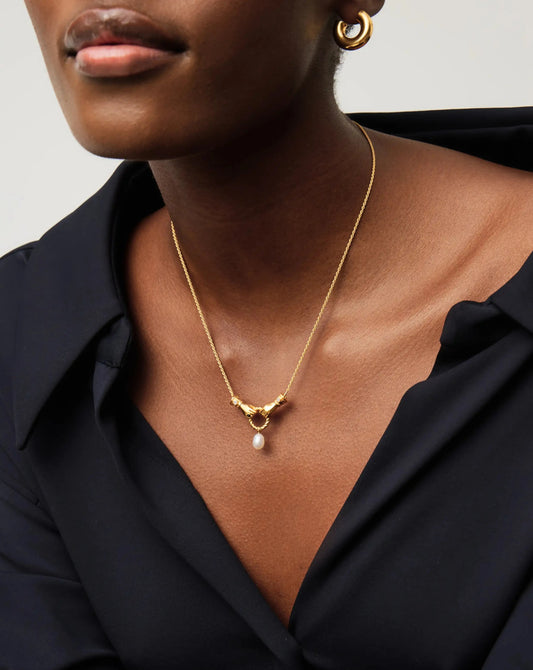
How to: Clean Your Gold Jewelry
Gold getters, this one's for you. Here's how to keep your pieces shining for as long as possible. Let's get into it.
![[two-img]](https://cdn.shopify.com/s/files/1/0286/4703/0828/files/1_480x480.webp?v=1730375826)
![[two-img]](https://cdn.shopify.com/s/files/1/0286/4703/0828/files/2_480x480.webp?v=1730375848)
What is the Difference Between Gold-Plated and Gold Vermeil?
Most of our jewelry is handcrafted in 18k gold vermeil (pronounced ‘ver-may’). In simplest terms, it has a thicker layer of gold added to the base of sterling silver. The thickness of the gold must be a minimum of 2.5 microns to be classed as gold vermeil. All gold vermeil jewelry in the UK is stamped with the '925' mark to indicate the sterling silver purity.
The plating process is different as well — gold vermeil is plated with a process known as ‘electrolysis’, making the jewelry very durable. All our pieces are tested by the Assay Office (which tests the purity of precious metals), as required by law. Gold plated jewelry, on the other hand, involves a base metal, such as brass, which is coated with a thin layer of gold.
The gold layer used in gold-plated jewelry is typically less than 1 micron thick, making it more affordable but less durable compared to gold vermeil. The thin gold layer makes gold-plated jewelry more susceptible to wear and tear than gold vermeil.

Does Gold Jewelry Tarnish?
Yes, 18k gold vermeil and 18k gold-plated jewelry can tarnish over time if not properly cared for. Exposure to chemicals like perfumes, lotions, and deodorants can contribute to this. To prevent tarnishing from happening, make sure you are regularly cleaning and properly storing your pieces. We suggest avoiding swimming or showering while wearing gold jewelry. Chlorine, salt water and fresh water can also damage precious metals.
On the other hand, 14k solid gold is resistant to tarnishing which is why it makes the perfect investment pieces. Look to our solid gold and diamond edit for a little bit of luxury.

How to Clean Gold Jewelry in Three Steps
01. Gently rub your piece with a soft microfiber cloth to polish it.
02. For deeper cleaning, use mild dish soap with warm water and a soft-bristle toothbrush.
03. Rinse with lukewarm water and dry with a clean cloth.
![[two-img]](https://cdn.shopify.com/s/files/1/0286/4703/0828/files/How_to_Solid_Gold_Jewellery_480x480.webp?v=1730377361)
![[two-img]](https://cdn.shopify.com/s/files/1/0286/4703/0828/files/How_to_Solid_Gold_Jewellery_2_480x480.webp?v=1730377428)
How to Clean Your Solid Gold
Solid gold is made to stand the test of time, meaning it should not oxidize or discolor. That’s why we recommend our 14k solid gold as the ultimate investment pieces.
Do avoid chemicals when wearing your fine jewellery and take off while showering or bathing so it’s not affected by the products you’re using. Because solid gold is a soft metal, be extra careful in circumstances where your jewellery may get bumped or scratched. Otherwise, it can be cleaned in the same way as your gold vermeil pieces.

How Should I Store My Gold?
Reuse the pouch from your recyclable Missoma packaging to keep your pieces separate. This will keep them from rubbing together, scratching or tangling. Living in a humid environment? Store your pieces with a small packet of desiccant crystals to help reduce tarnishing.
How Often Should I Polish My Gold?
Depending on how often you wear your pieces we suggest polishing them either every few weeks or every few months. Less frequently worn pieces only need to be polished at most a few times a year. In between polishes, keep your jewelry away from chemicals and by store them in a dark and dry place.
Tips for Cleaning Gold Earrings
Gently rub the earrings with the soft, non-abrasive, and lint-free cloth or chamois to remove surface dirt and oils. Rinse thoroughly with lukewarm water and dry with a clean cloth. To prevent future tarnish, store your gold earrings in a dark, cool place and avoid exposing them to harsh chemicals or moisture.
Tips for Cleaning Gold Rings
Wanting to clean your stacking or statement rings? Use a mild dish soap with warm water for a deeper clean, alongside a soft-bristle toothbrush. Rinse the ring thoroughly with lukewarm water and dry it with a clean cloth.
Tips for Cleaning Gold Necklaces
Whether you're cleaning your chains, pendant necklaces, or chokers, use a soft microfiber cloth to rub the necklace's surface gently. We don’t recommend the use of any jewelry polishing cloths which have been treated with cleaners or polishing agents.







